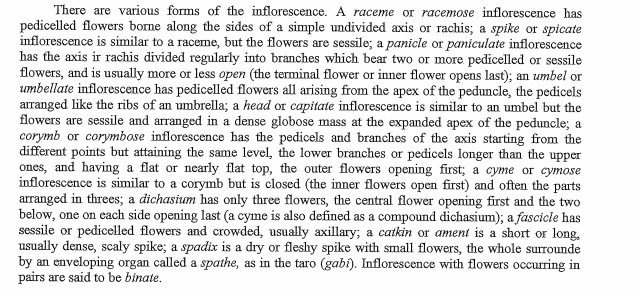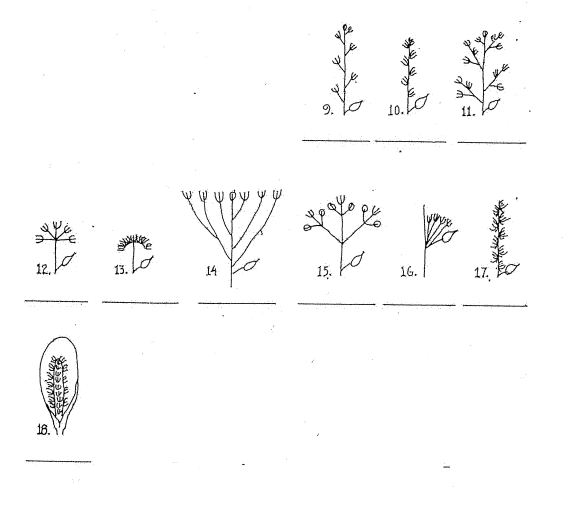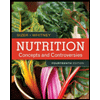Nutrition: Concepts and Controversies - Standalone book (MindTap Course List)
14th Edition
ISBN:9781305627994
Author:Frances Sizer, Ellie Whitney
Publisher:Frances Sizer, Ellie Whitney
Chapter12: Food Safety And Food Technology
Section: Chapter Questions
Problem 15SC
Related questions
Question
Bougainvillea, sunflower, and hibiscus, what is the form of inflorescence in these figures? Based on the text.

Transcribed Image Text:There are various forms of the inflorescence. A raceme or racemose inflorescence has
pedicelled flowers borne along the sides of a simple undivided axis or rachis; a spike or spicate
inflorescence is similar to a raceme, but the flowers are sessile; a panicle or paniculate inflorescence
has the axis ir rachis divided regularly into branches which bear two or more pedicelled or sessile
flowers, and is usually more or less open (the terminal flower or inner flower opens last); an umbel or
umbellate inflorescence has pedicelled flowers all arising from the apex of the peduncle, the pedicels
arranged like the ribs of an umbrella; a head or capitate inflorescence is similar to an umbel but the
flowers are sessile and arranged in a dense globose mass at the expanded apex of the peduncle; a
corymb or corymbose inflorescence has the pedicels and branches of the axis starting from the
different points but attaining the same level, the lower branches or pedicels longer than the upper
ones, and having a flat or nearly flat top, the outer flowers opening first; a cyme or cymose
inflorescence is similar to a corymb but is closed (the inner flowers open first) and often the parts
arranged in threes; a dichasium has only three flowers, the central flower opening first and the two
below, one on each side opening last (a cyme is also defined as a compound dichasium); a fascicle has
sessile or pedicelled flowers and crowded, usually axillary; a catkin or ament is a short or long,
usually dense, scaly spike; a spadix is a dry or fleshy spike with small flowers, the whole surrounde
by an enveloping organ called a spathe, as in the taro (gabi). Inflorescence with flowers occurring in
pairs are said to be binate.

Transcribed Image Text:10.to
9.
12.
13. Lo
15. Lo
16.
14
16.
Expert Solution
This question has been solved!
Explore an expertly crafted, step-by-step solution for a thorough understanding of key concepts.
Step by step
Solved in 2 steps

Knowledge Booster
Learn more about
Need a deep-dive on the concept behind this application? Look no further. Learn more about this topic, biology and related others by exploring similar questions and additional content below.Recommended textbooks for you

Nutrition: Concepts and Controversies - Standalo…
Health & Nutrition
ISBN:
9781305627994
Author:
Frances Sizer, Ellie Whitney
Publisher:
Brooks Cole

Lifetime Physical Fitness & Wellness
Health & Nutrition
ISBN:
9781337677509
Author:
HOEGER
Publisher:
Cengage

Nutrition
Health & Nutrition
ISBN:
9781337906371
Author:
Sizer, Frances Sienkiewicz., WHITNEY, Ellie
Publisher:
Cengage Learning,

Nutrition: Concepts and Controversies - Standalo…
Health & Nutrition
ISBN:
9781305627994
Author:
Frances Sizer, Ellie Whitney
Publisher:
Brooks Cole

Lifetime Physical Fitness & Wellness
Health & Nutrition
ISBN:
9781337677509
Author:
HOEGER
Publisher:
Cengage

Nutrition
Health & Nutrition
ISBN:
9781337906371
Author:
Sizer, Frances Sienkiewicz., WHITNEY, Ellie
Publisher:
Cengage Learning,

Essentials Health Info Management Principles/Prac…
Health & Nutrition
ISBN:
9780357191651
Author:
Bowie
Publisher:
Cengage